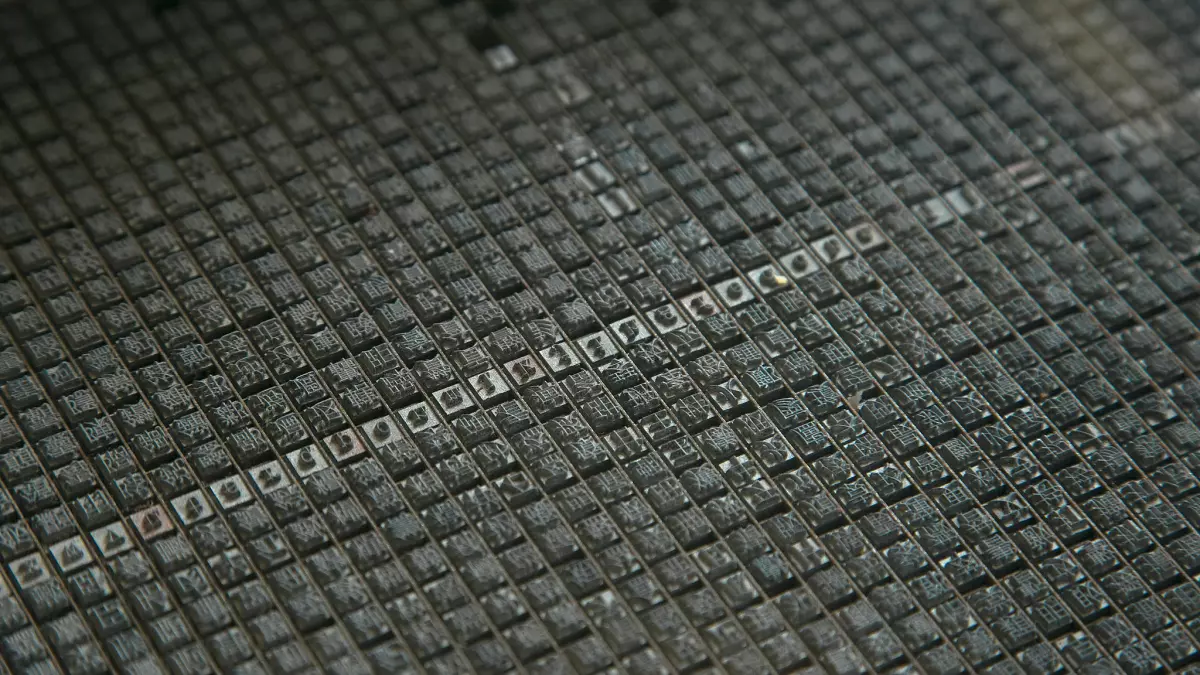Ground Writing
The story that follows is set in the near future. It originally appears in the book Image RIP by Geoff Han, published by Source Type. Read more about the book here.
The message came from about halfway around the world, from some friends I met last summer who were now busy organizing a large group of people. They use, almost exclusively, secure messaging. Telegram specifically.
Telegram was introduced as a simple messaging service and as an alternative to the standard iOS or android messaging apps. It is not owned by any social network, though it is in direct competition with WhatsApp, which is owned by Facebook. It’s encrypted. Every message along its entire route is unreadable, by both the servers that touch it, and also by any of the intermediate software that routes the message from one place to the other. Public-private secure key pairs at either side of the transmission between trusted users encode and then decode the message only at the sender and receiver end so there’s no data capture possible en route.
I tapped the first three letters into the omnipresent search bar on my Team 6AC:
“w-a-t …”
Software took over and finished my thought, soon searching the Internet for “water”:
Water, a substance composed of the chemical elements hydrogen and oxygen and existing in gaseous, liquid, and solid states. It is one of the most plentiful and essential of compounds. A tasteless and odorless liquid at room temperature, it has the important ability to dissolve many other substances. Density: 997 kg/m³ Boiling point: 212°tF (100°C) Molar mass: 18.01528 g/mol Melting point: 32°F (0°C) Formula: H2O
I recalled the water writers I’d seen about eight years ago in Jingshan Park in Beijing, right next to the Forbidden City. They were mostly older men but not exclusively. One woman I remembered in particular because she held brushes in both hands and wrote two columns of mirrored calligraphy at the same time.
Water calligraphy, better known as Ground Writing or 地书 (Pinyin “Dishu”) in Chinese, appeared at the start of the 1980s in Beijing. This was around the time of the “Reform and Opening Up” policy and since then ground writing has spread to public parks all over China.
The calligraphers write poetry, mostly short traditional verse. Most of them are retired. One 79-year-old described to me, “This is just for fun! You have to do something when you get old right?” They use homemade brushes fashioned from broomsticks and hand-cut brushes made from sponges, rags, mops, whatever they can find. They write directly on the ground, in public space. Since it is written in water not ink, it is explicitly ephemeral.
On this day in Jingshan Park, there were about five writers positioned with a graceful distance between them. I was fascinated by the ritualized order in which the strokes that define any character were drawn. I later understood that stroke order is essential in Chinese writing—a different order would suggest a different character. Nearby, newspapers hung for public reading. The proximity, even overlap, of reading and writing in this public space made a strong impression on me and I recalled the story of British Romantic poet John Keats who died young and asked to be buried in an unidentified grave marked only by the epitaph:
Here lies One Whose Name was Writ in Water.
All writing should be done like that. Carefully. Temporarily. In public.
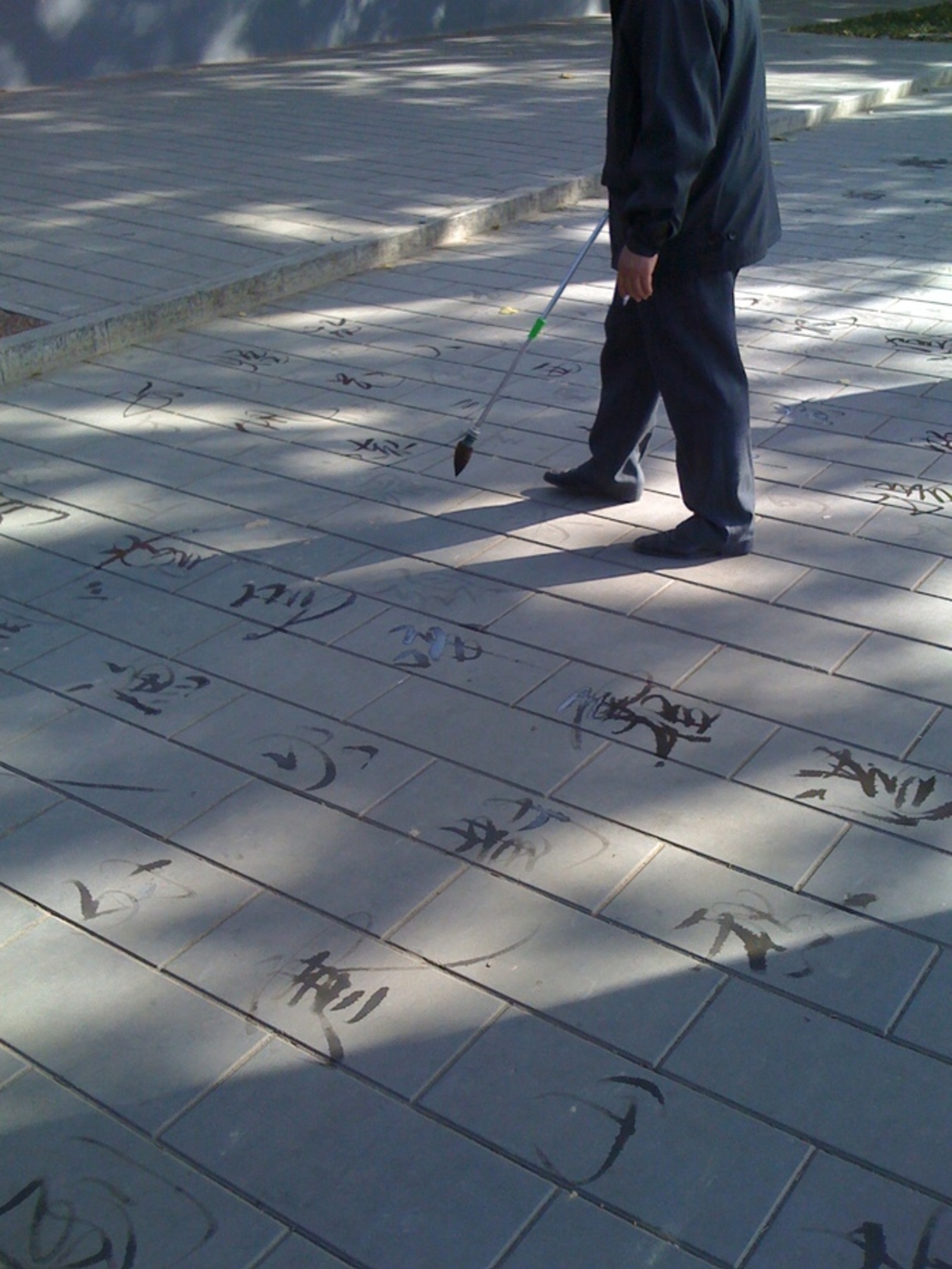
Water calligraphy, better known as Ground Writing or 地书
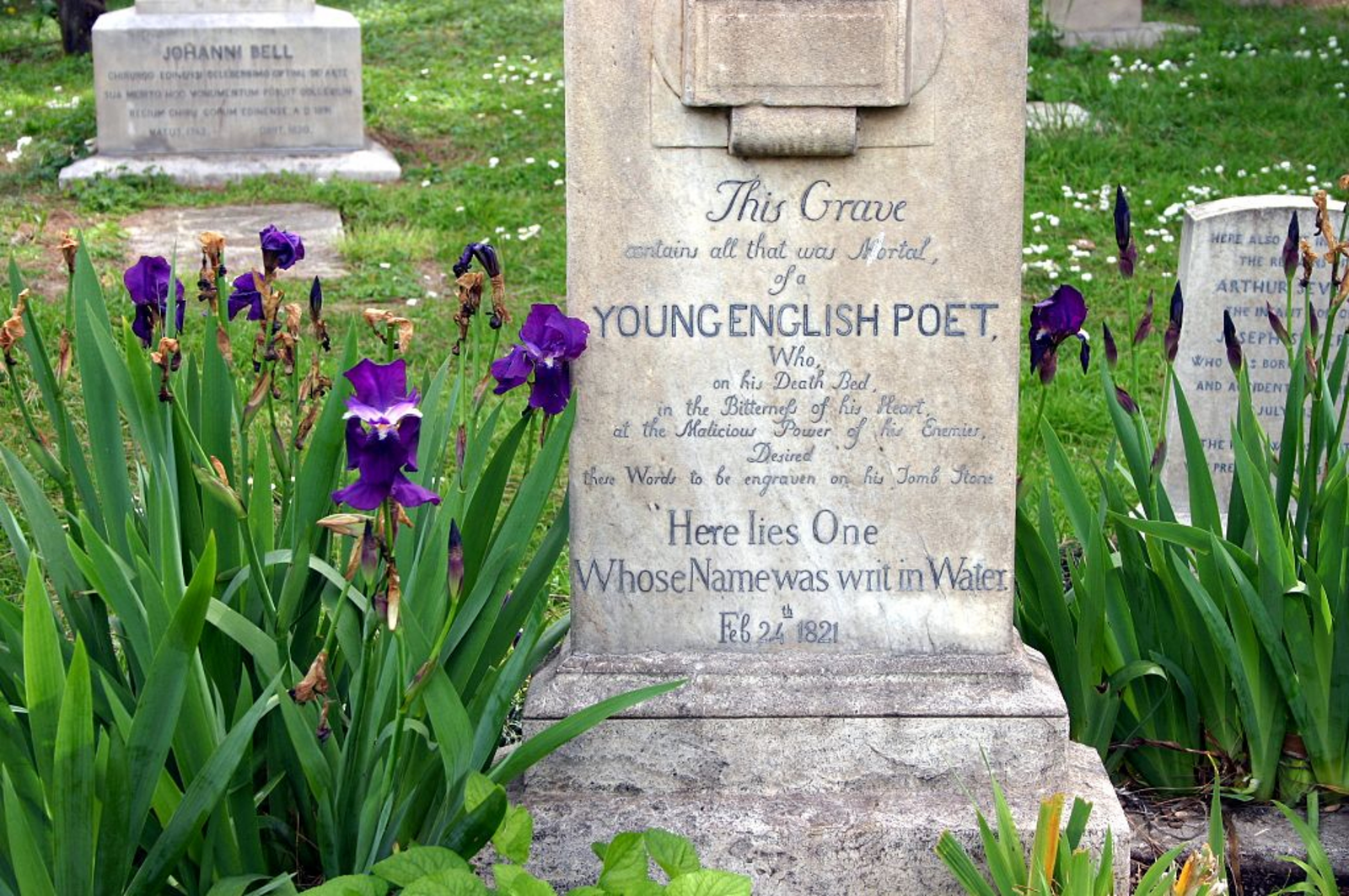
The gravestone of John Keats in the Cemitero Acattolico, Rome
I scrutinized the characters on my phone trying to perform a reverse lookup in my brain, to find a connection, a tendril line between shape and meaning. But alternate character text input on the app was awkward, well at least for Chinese traditional or simplified characters. Chinese characters are logograms (well, not exactly), where each one stands for a syllable in a compound word and that works very differently from an alphabet where the letter stands for a sound and combinations of letters add up to combinations of sounds and combinations of sounds produce words. Pronunciations and vocabulary differ between languages, of course. To me, it seemed that maybe writing in logograms was simpler and more direct, something more like traversing the world in images, somehow just less linear and literal.
Traditional Chinese consists of 70,000 characters. Learning to read and write it is complicated. Simplified Chinese was introduced around the cultural revolution in China and reduced the character set to somewhere around 20,000 (8,105) unique logograms. The not-entirely-unique base shapes are combined to make words which might refer to things or concepts. Simplified Chinese was intended to be much easier to learn to read and write and would promote literacy throughout the entire country as am integral part of the Great Leap Forward imagined by the early Communist government.
But regional dialects held on. The more remote, the more discrete, the region the stronger the dialect. Dialects evolve in cloistered communities that choose coded methods for speaking among some cells so that others don’t understand is said. As a result, connections become stronger, but also more fluid. The speed of dialect creation in dataspace is much faster and in every way more fluid.
In Hong Kong, students learn to write traditional Chinese in school but learn to speak predominantly Cantonese. Cantonese is a dialect that emerged in southern China during the Song Dynasty about 1000 years ago. Mandarin is a northern dialect that evolved under the influence of neighboring cultures, later becoming the official state spoken language of China. The two dialects are distinct and mostly mutually unintelligible
I remembered something I’d heard before:
“Be like water.”
A quote by Bruce Lee from a 1953 movie, the rest follows:
“Don’t get set into one form, adapt it and build your own, and let it grow, be like water. Empty your mind, be formless, shapeless — like water. Now you put water in a cup, it becomes the cup; you put water into a bottle it becomes the bottle; you put it in a teapot it becomes the teapot.”
Keyboard Variations
Writing for me, like anyone these days, is mostly on my phone. Mine’s brand new, flexible, and waterproof—pretty slick. The text entry interface which shipped with the phone perhaps hasn’t caught up to its external form with its grapheme coating to keep the device cool and unbreakable diamond glass on the front. Absolutely edge-to-edge, back and front interface. And still, referencing these characters was awkward. Writing them was a chore, and so I tried a few of the different methods commonly available. If you ask 10 different Chinese speakers to type the same message in traditional characters on their phone, each of the 10 would do it a different way.
The most popular is Pinyin. It’s based on phonetics, although perhaps surprisingly is typed in Roman characters with English pronunciation. Using a standard QWERTY keyboard, the user types in a phonetic approximation of the sound of the character they’re searching for. After entering perhaps three English letters then a constellation of possible Chinese characters which begin with that sound appear above the keyboard to choose from. This method of text input relies on being able to speak the language, but there’s no need to be able to write it, exactly. Recognizing the symbol is enough, rather than recalling it from memory and knowing how to write it.
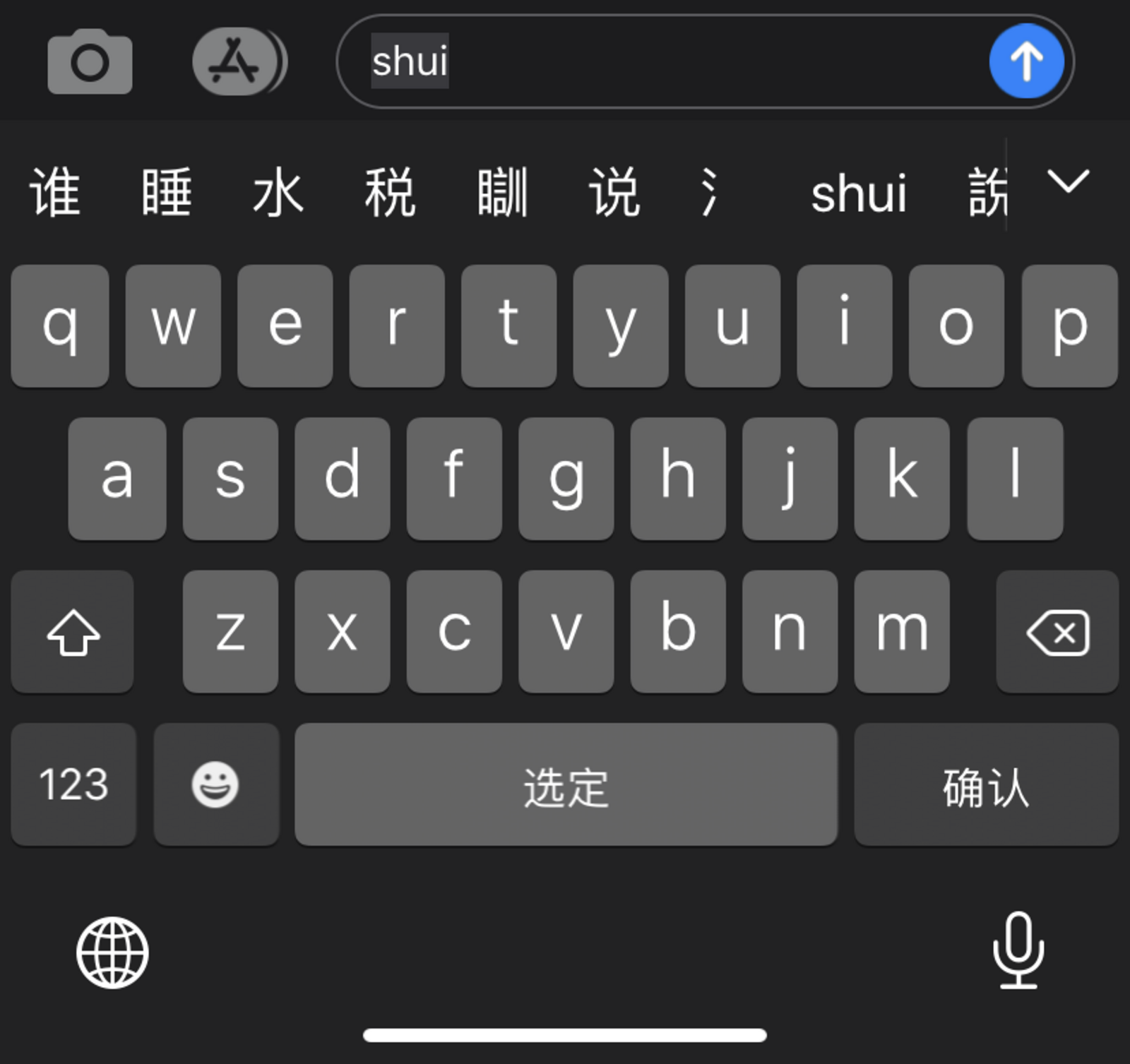
Pinyin keyboard layout
Being the most popular way to enter text, it also comes at the expense of the persistence of written Chinese language. The more people know how to speak it and say it and approximate it with English characters, the less essential it is to know how to write the actual characters.
Other methods use the shapes of letters. The most common of these methods is Cangjie. Cangjie is a set of 24 root characters, or radicals, which are used in combination to specify a more complex Chinese character. The system was developed around 1976 when when it became obvious that text entry on computers would soon dominate written communication. Computers use the keyboard already, so having a Chinese “alphabet” of sorts was a handy solution to the unwieldiness of the written language. 24 was also a handy number seeing as it neatly mapped on to the existing hardware.
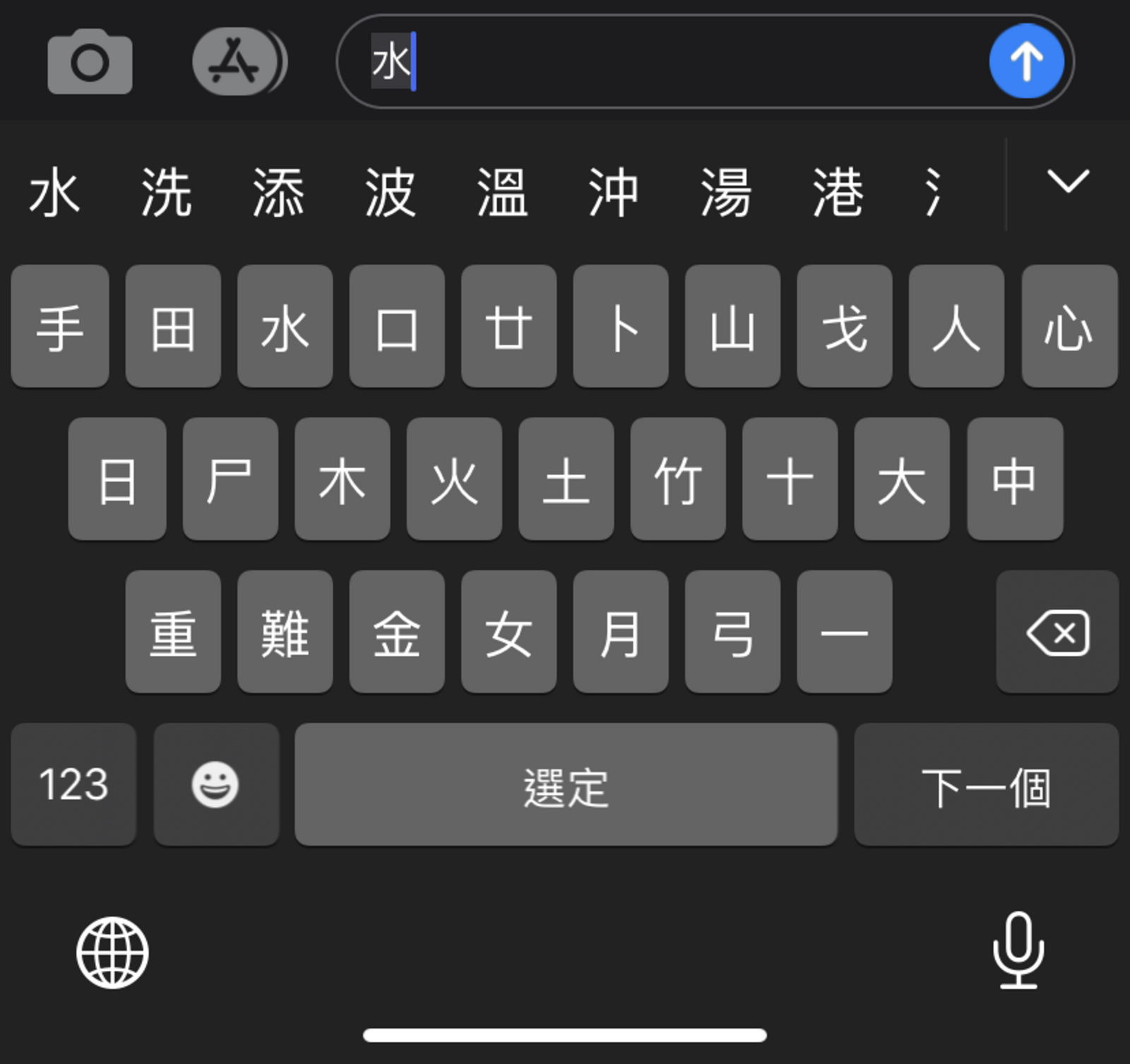
Cangjie keyboard layout
A third category of text entry methods more explicitly encourages writing. These are the stroke-based methods of text input. They appear, also, at first to also be the simplest and most direct. It is also the easiest one to learn—the keyboard itself is minimal, and there is no need to be able to speak the language only to be able to recognize the forms of its writing.

Wubihua keyboard layout
When writing Chinese, either simplified or traditional, the stroke order is meaningful and follows a sequence of eight basic rules which govern which strokes in a specific character are to be drawn before which other strokes. Changing the order changes the possible characters, so when entering strokes using a predictive text or autocomplete algorithm, then the wrong stroke order may eliminate the character you were trying to write, with autocomplete offering a series of characters which look similar but mean something completely different.
One stroke-order method for text input is called Wubihua. It was developed explicitly for mobile phones and their limited keyboard real estate. Wubihua uses only five keys, the numbers 1-2-3-4-5, to identify five different kinds of strokes. The first is a horizontal stroke from left to right, the second is a vertical stroke from top to bottom, the third is a left-falling stroke, the fourth is a right-falling stroke, and the fifth is a hook. As the user enters these strokes in a specific order, a group of characters that match these construction instructions appear above the soft keyboard on the interface. The user selects the character they intend and proceeds to the next set of strokes. This can be pretty fast as even entering just a few strokes limits the number of possibilities substantially.
But what really turbocharges any one of these input methods (Pinyin, Cangjie, Wubihua) is data. Personal data. What the software knows about you, the user, and your patterns of speech, writing, of where you are in the world, who you’re speaking to, what you said yesterday, what you said last week, and what you might likely say tomorrow. Given all of the personal information that our mobile phones bleed, the text prediction algorithm can usually almost magically predict what it is you want to say. We know this in writing in English on a regular QWERTY keyboard where predictive text both speeds entry (good) and also corrals our meaning in the prescriptive language formations (bad). We trade range of expression for typing speed, happily.
Text entry speed has always been an issue as long as there have been keyboards. The standard QWERTY keyboard layout for the 26-letter Latin character alphabet of English. It was invented for mechanical typewriters and I’d always heard that the arrangement of letters was meant to slow down typing. Early typewriters too often got stuck when trying to stamp letters too quickly. The problem was just that people type too fast and the mechanism couldn’t keep up. By instituting a less-intuitive layout of the characters across a keyboard, users typing fees were slow down the machine worked. But recently I learned this wasn’t exactly true. Even if it was all over the Internet.
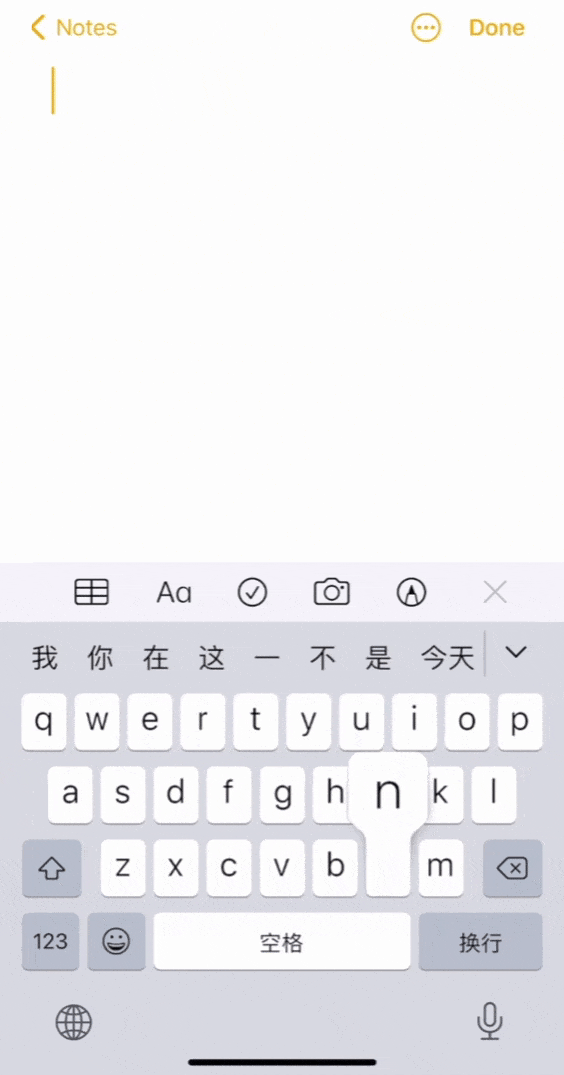
Typing using the Pinyin input method
QWERTY Revolution
Double Pigeon Chinese Typewriter in use
In 2011, researchers in Japan posted a paper detailing the development of the QWERTY keyboard layout. “On the Prehistory of QWERTY” addresses the frequently asked question “why are the letters on the keyboard arranged the way they are?” and arrives at a new answer. According to Koichi Yasuoka and Mototoko Yasuoka, the specific keyboard arrangement had nothing to do with the mechanism of a typewriter but rather was developed years earlier around the telegraph. And counter to what the Internet would have us believe, it had everything to do with *efficiency* in entering text, which was to be encoded in Morse code for the telegraph machine. The pair describe the evolution of this specific keyboard layout as a process of refinement and development, of expediency and convenience.
The first commercially successful typewriter was developed from around 1868 by Americans Christopher Latham Sholes, Frank Haven Hall, Carlos Glidden, and Samuel W. Soule in Milwaukee, Wisconsin. An early market for the writing machine, was the telegraph industry. Telegrams were messages sent between geographically distant points on electric wires, allowing long-distance communication, a frighteningly new thing in the middle of the 19th century. Telegraph transmissions were sent using Morse code, a combination of short and long electric pulses which stand for each of the letters of the English alphabet. The typewriter might then be used to transcribe a telegraph transmission, and produce a clear and human-readable document. Sholes, Hall, Glodde, and Soule’s first client for their writing machine was nearby Porter’s Telegraph College in Chicago.
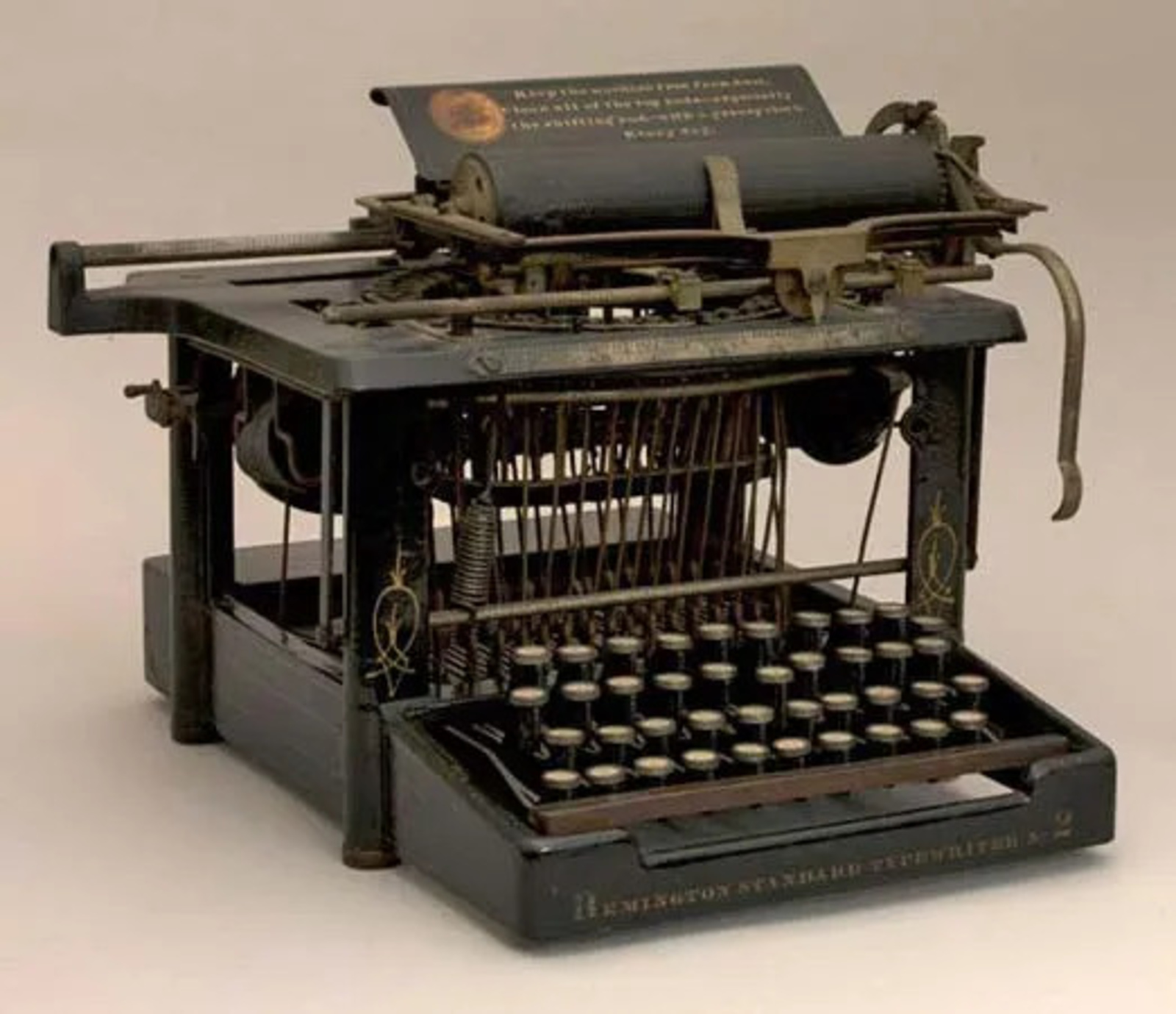
Remington No. 1 Typewriter (1874)
In 1868, their first machine used a keyboard of 28 keys, laid out like a piano with A-N left-to-right on the black keys, and O-Z from right-to-left on the white keys. You’ll notice there are no number keys. Porter’s Telegraph College noticed this also and insisted that a more compact layout be instituted. A couple of years later the keyboard had been significantly re-organized into four rows, with the bottom two rows made up of consonants in alphabetical order, the third row with vowels and punctuation, while the top row had the digits 2-9 plus a hyphen. There was neither a “1” nor a “0” key.
For cost efficiency and manufacturing simplicity, “1” was typed as the letter “I” and the letter “O” was used for “0.” When the machine was offered to the American Telegraph Company, additional refinements were made with the frequently typed letter “T” moved to the top center of the keyboard, the W moved to the top row with the vowels, And the less-used “Q” moved to the left-edge of the keyboard.

Typewriter Keyboard Arrangement (1870)
By 1872, when the machine was presented to the Western Union Telegraph Company, additional keyboard layouts were suggested by the telegraph operators. Since telegrams used numbers frequently in the short messages, “I” and “O” were moved to the third row far right, close by and just underneath the rest of the digits. The hyphen key was placed at the top right of the keyboard, as “——” was used to identify paragraph breaks in a telegram. Looking at a QWERTY keyboard today you can see the vestiges of these decisions with the I, the O, and the hyphen remaining in these positions.
Chinese typewriters were something else. To mechanically arrange the sequence of characters possible in as many as even a bare minimum of 2500, distinct metal pieces had to be arranged in some kind of accessible and indexable manner. This required more than one tray of characters and a selection mechanism for choosing the required character. Chinese typewriter designs often employed more than one deck of metal characters arranged in so many trays. The most successful of these typewriters was called the Double Pigeon.
“The Double Pigeon model typewriter appeared around 1974 and was widely adopted. The Double Pigeon used a selection arm and two trays of characters to select from. In total, the machine had approximately 2500 characters, a barely rudimentary set But more than could fit in the type tray. Additional boxes of characters how less frequently use glyphs. The organization of the type trays could be changed to suit the user. Individual characters are selected by a movable arm along a grid to select a character, which is picked up and used to print on a paper roll. The machines had no keyboard. Using the a Double Pigeon was complex operation with the operator hunting and searching and selecting and printing and returning and hunting and searching and selecting and printing and returning in an intricate dance of body and memory. (MC Hammer even named the signature dance move from his Grammy-winning hit “You Can’t Touch This” (1990), “The Chinese Typewriter.”)”
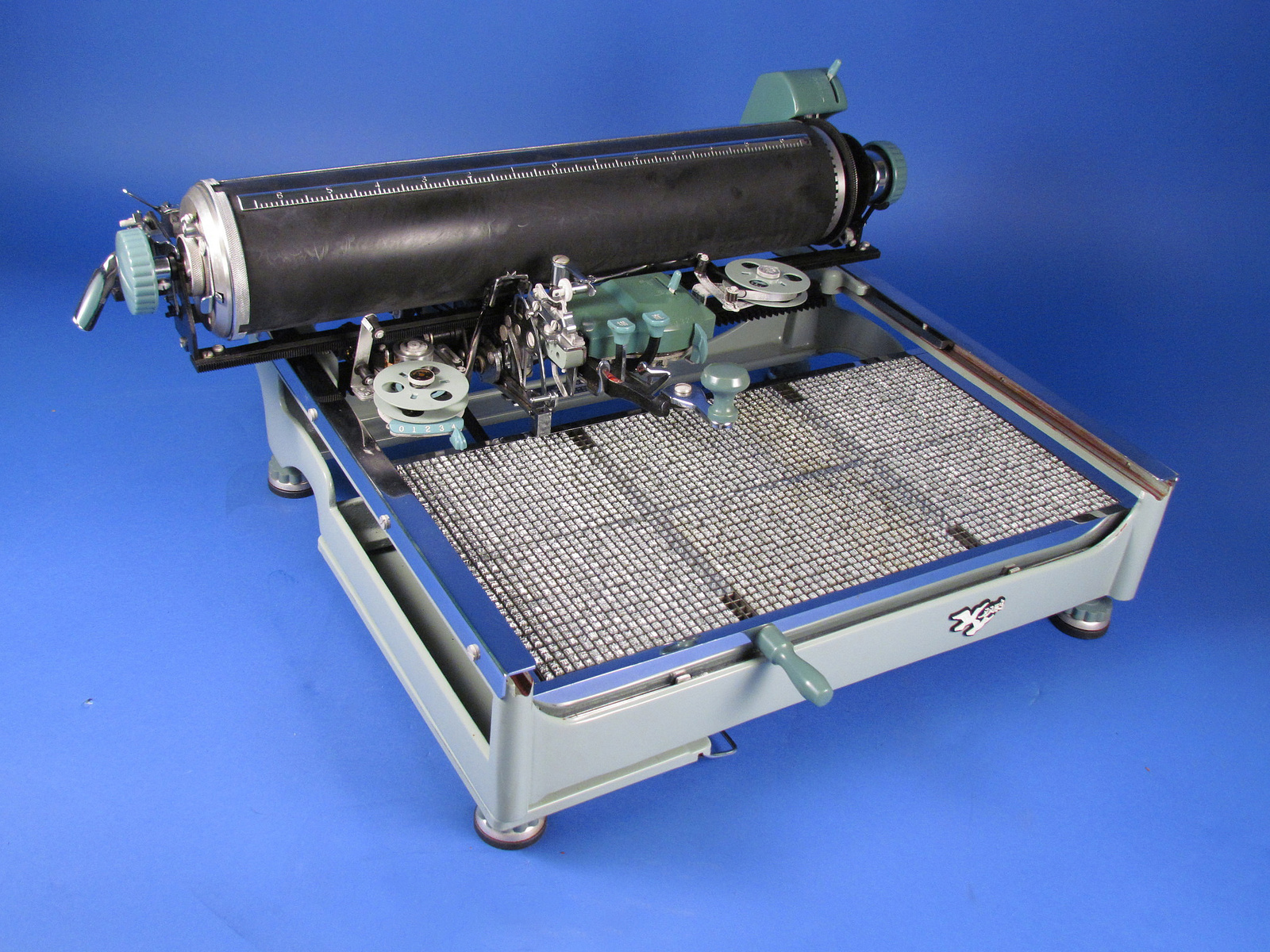
“Double Pigeon” Model DHY typewriter (c. 1974)
M.C. Hammer performing his signature dance “The Chinese Typewriter” from his song “You Can’t Touch This” (1990)
Movable Type
Movable type was invented in China during the Northern Song dynasty around 1040 AD by inventor Bi Sheng. He first used wooden individual characters set together in an iron frame to make multiple copies of a text. However the woodgrain was a problem, making the character less legible and the letter also less durable. Instead he invented a working system using ceramic characters, specifically porcelain, which resulted in extraordinarily durable, tough, and precise letters. Bi had somewhere around 2000 types, with around 20 copies of the most frequently used characters. This process was inefficient for printing small quantities, but when the numbers increased, the efficiency also increased. By somewhere around 1180 printing was being done using metal (bronze) types with some success. Bi’s method was evolved most significantly 150 years later by Wang Zhen who created 30,000 characters (this time of wood) and also invented a sorting method to find a specific character character when needed, as needed. As well, Wang published a book describing his process called *A method of making movable wooden types for printing books.* (It wasn’t until the middle of the 15th century that printing with movable type appeared in western Europe.)

Wang Zhen’s Revolving Typecase
With movable type as well as for Chinese typewriters, the most perplexing problem was always how to arrange the characters so that they could easily be found when needed. This organization scheme, protocol, or lookup table, is absolutely essential to make typesetting or typewriting (or later computer text entry) in Chinese characters practical. Approximately 3,000 to 4,000 characters are needed to read and write Chinese fluently. More like 40,000 characters are often used to set complicated texts.
Around 1959 in Cambridge, Massachusetts at MIT, Dr. Samuel Caldwell approached this problem of Chinese text input. Caldwell was an electrical engineer and a computer scientist before there was really either computer science or much in the way of practical computers. However, he became interested in how to design a computer which would understand and produce written Chinese. This was at the height of the Cold War, and the United States “needed a win,” according to Stanford historian Tom Mullaney. The Soviet Union had recently launched the Sputnik satellite into space and in 1958 Mao Zedong had instituted China’s Great Leap Forward. If the United States could develop a computer that operated in Chinese, the possibility of producing text and therefore propaganda was enormous. Faced with this challenge, Dr. Caldwell consulted Chinese graduate students over casual group dinners and learned something surprising to him. Written Chinese has an orthography. A Chinese character is always written the same way with strokes drawn in a prescribed order which follows a set of discrete rules. Further, there are a limited number of stroke types, eight main categories are agreed on today.
1. Horizontal
2. Vertical
3. Left-falling
4. Right-falling
5. Rising
6. Dot
7. Hook
8. Turning
These are drawn following a set of eight rules which determine the stroke order:
1. Horizontal then vertical
2. Left-falling then right-falling
3. Top to bottom
4. Left to right
5. If framed from above, frame first
6. If framed from below, frame last
7. Frames closed last
8. If symmetrical, middle first then sides
These rules determine a definite order, which when combined with a limited collection of strokes add up to a working orthography for writing Chinese. This was a revelation for Dr. Caldwell and his team. If Chinese characters had a definite construction order and they are made up from a basic set of strokes, then a particular character could be looked up by writing the strokes in the correct order. He soon also realized something even more remarkable which was that Chinese stroke order lookup is highly redundant. And so a character maybe made up of as many as 13 strokes or more however entering just the first four or maybe five strokes was enough to definitively identify the character in a lookup table. This logic worked beautifully on a computer which is designed to process large amounts of data and can index a large database from a particular query. Given the first four or five strokes as a query the computer could quickly find the matching character from a database of 40-70,000 possibilities. This lookup query and matching made Chinese possible and practical to enter on a computer. Typing was actually more like searching.
Given this collection of strokes and the set of rules, Dr. Caldwell landed on a 22-character “alphabet” of sorts. Working with a team including a professor of near Eastern languages at Harvard, Caldwell identified a small set of root glyphs, combinations of strokes written in a certain order, which frequently appear in written Chinese characters. Of course this wasn’t really an alphabet. In an alphabet, individual characters stand for specific sounds in a spoken language, and in this case the glyphs instead are only keys used to lookup the desired character in an indexing system. A 22-glyph set *was* convenient for mapping Chinese text entry onto the existing English QWERTY keyboard. A typist at this keyboard need only the first few “letters” of a Chinese word in order to identify the correct character. Rather than typing or spelling a word completely, this was more of a case of describing the intended word, searching a database and selecting the correct result. This team of engineers and linguists had unwittingly invented auto-completion.

Bi Sheng, inventor of movable type in China during the Northern Song dynasty (c. 1040 AD)
W-A-T-E-R
Chinese characters stand for single syllables. This derived from the fact that most ancient Chinese words were only one syllable. (This remains the case today.) As the language expanded and forked into the 70,000-character set of classical Chinese, words also became more complex. Characters adapted and it often required more than one character to represent a word. More often, characters are combined to make composite characters. Chinese writing evolved a clever graphic technique of combining multiple root glyphs into one character. Characters must always fit in a square. This is the case for single characters. And this is also the case when combining one or more characters into a compound character. in a square. By simply horizontally compressing the constituent characters, the resulting compound glyph still fits neatly in a square. An asterisk-shaped gridded paper is used when learning Chinese calligraphy for this purpose.
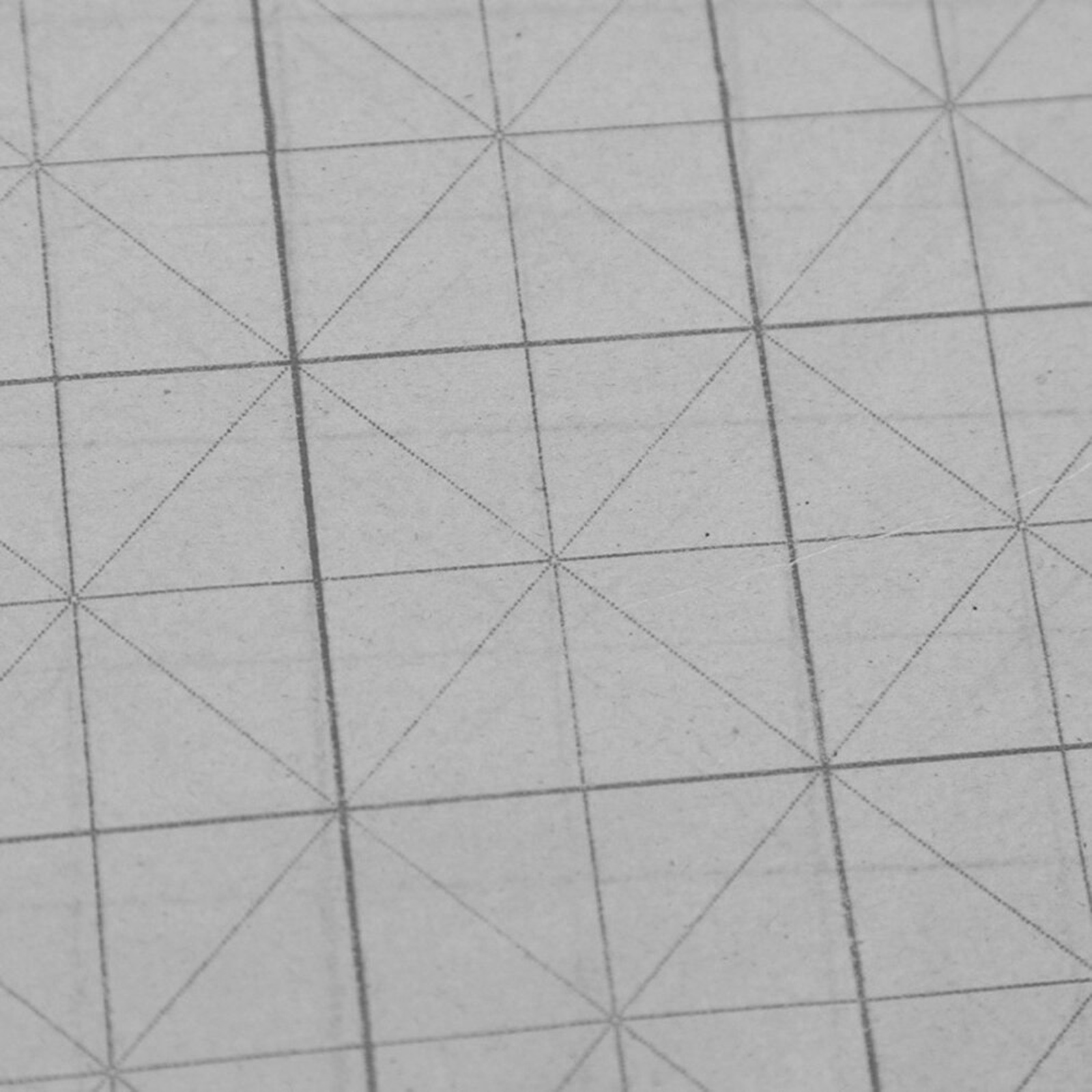
Grid paper used when learning Chinese calligraphy
Stroke order in Chinese writing is fundamental. It can be thought of, as Dr. Samuel Caldwell at MIT realized at the end of the 1950s, as a kind of “spelling.” Spelling in English determines the order that you write the letters that make up a word. In Chinese, rules determine the order that you write the strokes to make a word (character).
Writing “water” in Chinese (following the rules of stroke order), the first mark to draw is the long stroke in the center from top to bottom. The next stroke is a falling left stroke which connects to it. The next is the rising right stroke in the top-right of the character, and the final stroke is a downward right following stroke. The sequence looks like this:
丨
丨 乛
丨 乛 丿
丨 乛 丿 丶
or
水
English also relies on written order of the component letters that make up a word. So for example, writing “water” looks like this:
W
W-A
W-A-T
W-A-T-E
W-A-T-E-R
WATER
Making the marks in a different order (left-to-right) produces a different word, order produces meaning:
TAWER (a leather worker)
Or several:
A WET “R”
You could write the letters in a different temporal sequence, first write the “W” then write the “E” then write the “A” then right the “R” then write the “T” but in their regular linear positions. However nobody writes English like that. The orthography demands that it is always written from left to right. In English, you can read the order of writing, left to right, in the spelling of the word.
It’s not like that in Chinese. As Chinese characters always fit neatly into a square, then the stroke order or the order in which the marks were made is illegible in the final character. If an English word is a linear sequence produced by the order of writing, a Chinese character is not nearly so forthcoming. The final mark is a temporal whole where the stroke order is invisible.
The Wubi* Keyboard
Years ago, seeing the old man in Jingshan Park carefully perform his ground writing was a revelation in the making. Perhaps precisely because I don’t really read, speak, or understand Chinese, that I have often daydreamed about the possibilities for Chinese text input. After some marinating in my brain, I conceived a new idea, a new software called Wubi*, which aims to economize and speed things up considerably.
A soft keyboard obeys typical Team human interface design guidelines for mobile text entry interfaces, mimicking the layout of the Wubihua text entry method. Arranged across a set of five keys in the center, looking more or less like a numeric keypad from top left to bottom right, appear the same five constituent strokes. When typed in a specific order these also produce a series of possible Chinese characters. This works essentially the same way as Wubihua.
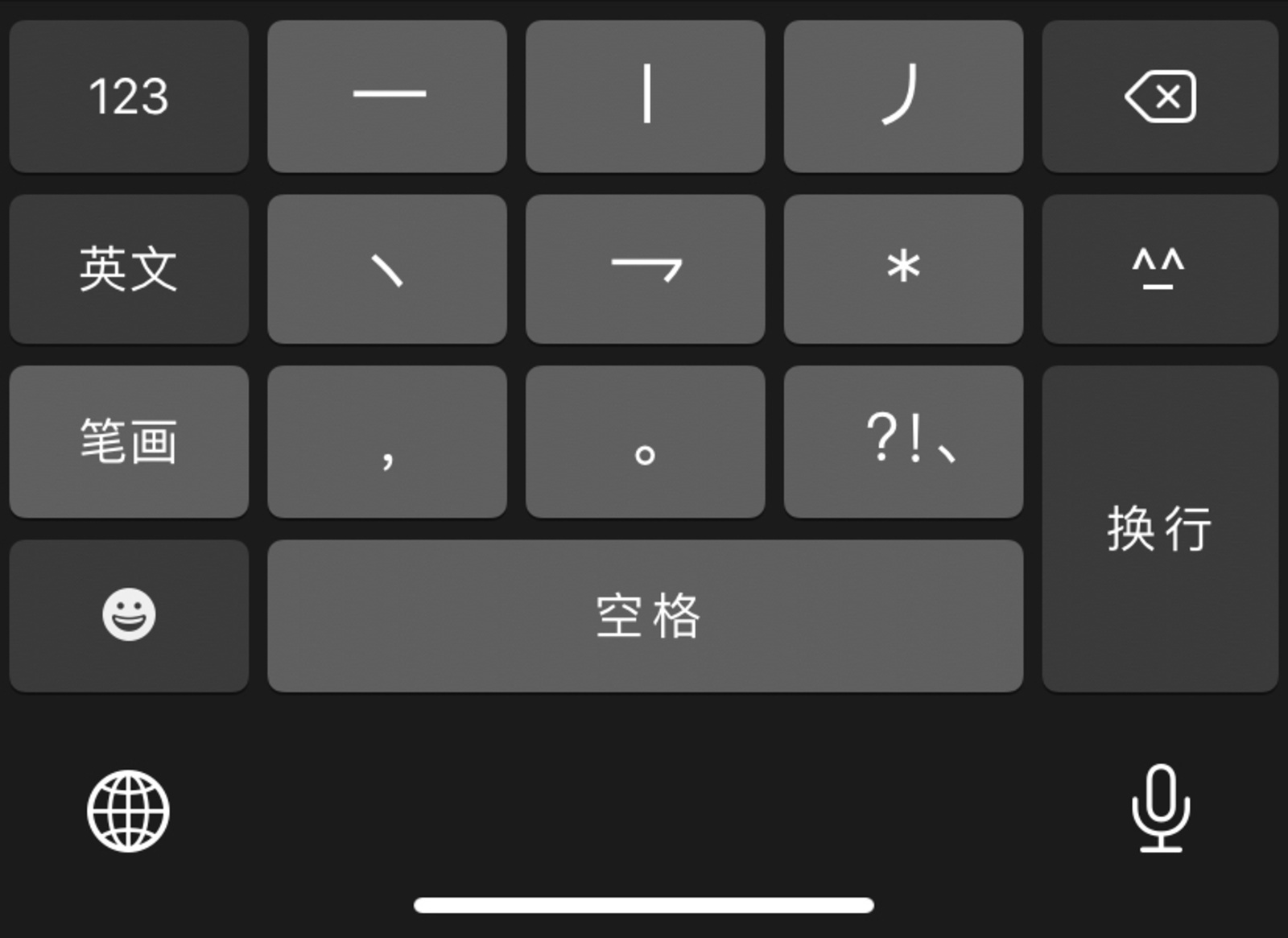
Wubi* keyboard layout
What has changed is the display of possible matches. Typically as a user enters the stroke radicals on a Wubihua keyboard, possible Chinese characters that match the order of the strokes entered so far appear above. Each stroke typed limits the number of characters that might appear based on stroke order.
Instead of a static table of possibilities organized on an expandable row, my display shows a flickering compound display of possible matches, organized against the scaffold of an 8-pointed asterisk-shaped grid. The strokes entered appear in the order that they were entered surrounded by the ambient flicker of an animation of all possible characters that fit this stroke sequence. Recall that scene from The Matrix where ‘reality’ is shattered into a sparkling green curtain of data, each character changing into every other possible character.
What animates my interface, the remaining strokes from characters that match the already entered strokes, is generated by a predictive text algorithm, which understands what has already been written grammatically and syntactically and then offers characters based on what is statistically most likely to follow. Typing anything on a mobile phone or entering terms in a Google search bar or filling out a form all use this behavior by default. This conflation of “search” and “writing” online is already the case, and my new interface simply takes that as a given.
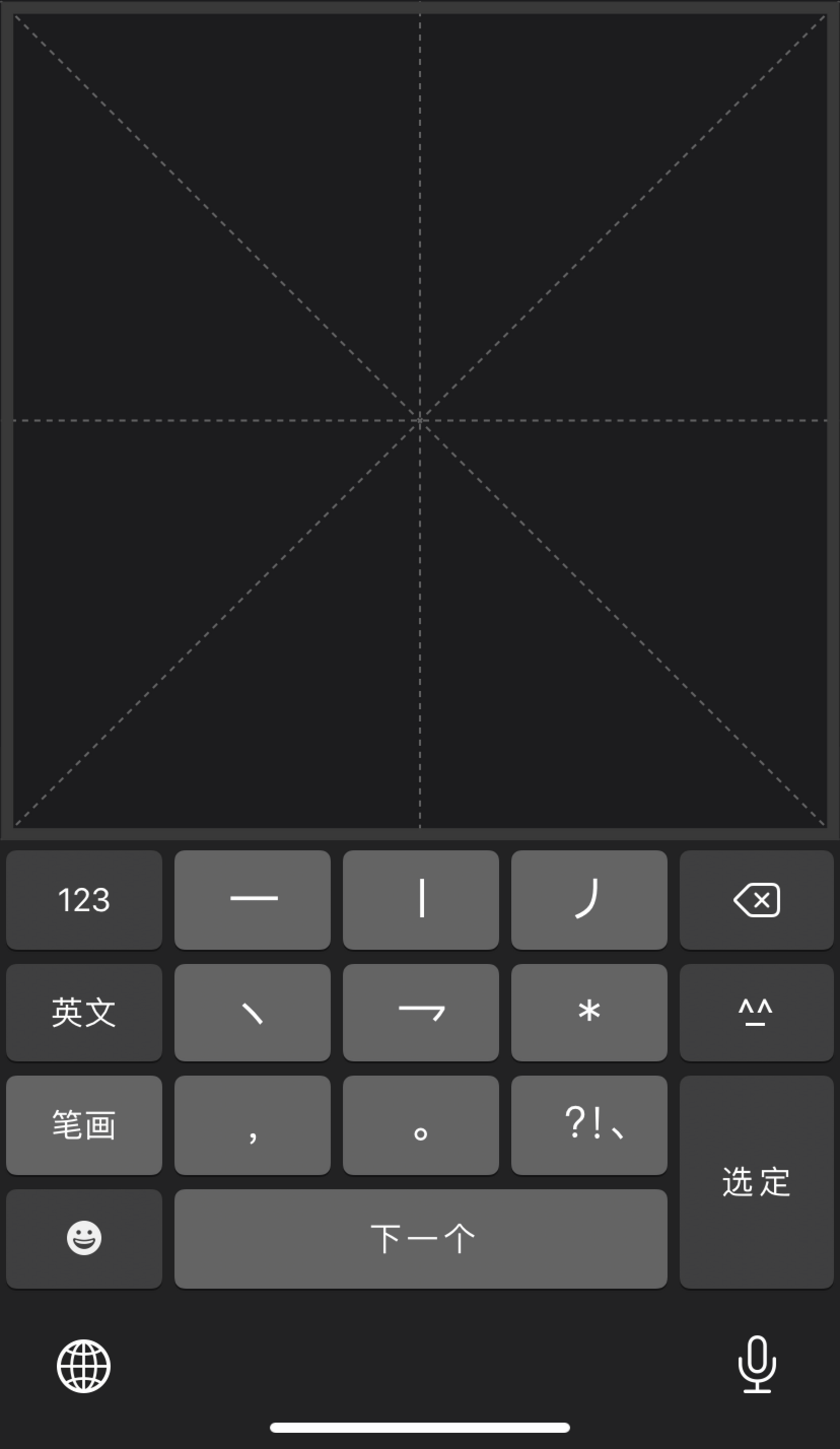
Wubi* phone interface
Entering Chinese characters in particular into a text interface is an exercise in “describe and retrieve.” Given the smallest amount of descriptive information (search terms), a database (the complete Chinese character set) is queried and possible matches (specific characters) are returned as results. Entering Chinese text into a machine has always relied on a lookup process like this.
The challenge of sending Chinese language over a telegraph line required a similar system. Telegrams are transmitted in Morse code, where strings of dots and dashes correspond to the letters of a Latin alphabet and digits. This would never work for 70,000 characters, so a secondary encoding was necessary. Chinese Telegraph Code was developed to address the issue and it maps a subset of approximately 7000 characters to discrete 4-digit numbers which map the characters lookup position in a code book. The code book is 100 pages, each organized as a 10 row by 10 column table of characters. The first two digits in the code identify the page number, the next identifies the row, and the last digit identifies the column.
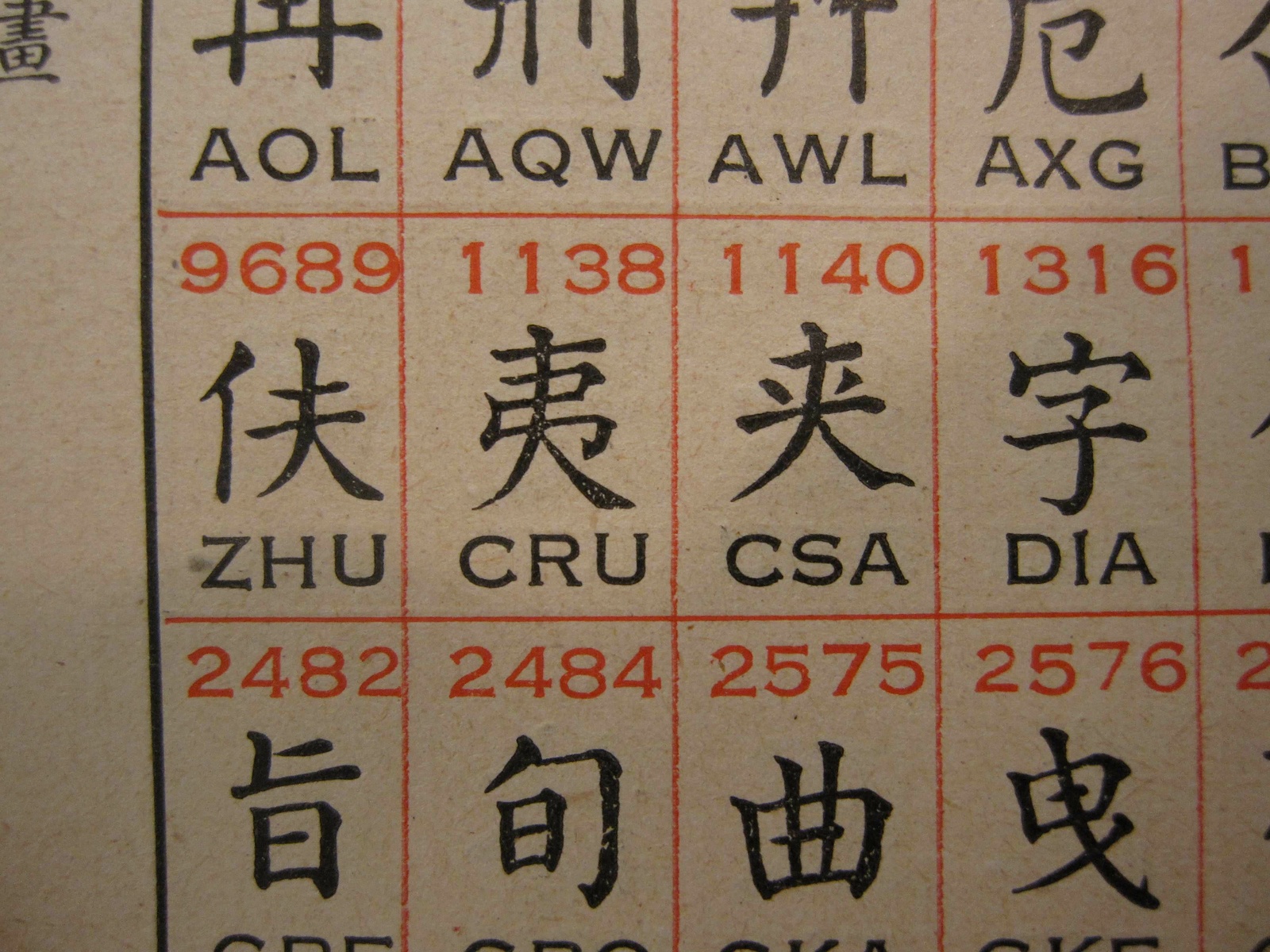
Chinese Telegraph Code book
These 4 digits are then transmitted as Morse code where on the receiving side they are decoded back into 4 digits which are used to lookup the character in a second copy of the Chinese Telegraph Code book. It was a heavy process and turns out that transmitting digits as a telegram was more expensive than sending letters.
But maybe the most difficult part of this was simply finding the character in the code book in the first place with so many to choose from and no simple way to organize the characters in the book. Decoding (4-digit code to character) was easy. Encoding (character to 4-digit code) was hard. In the 1920s The Four-Corner Method was developed to organize the Code book and to identify a character’s position in it. Given a particular character, the strokes in each of the four corners of the character are given a digit 0-9 which identifies the stroke type. This doesn’t definitively define the specific character, but it does limit the results to very few possibilities which can be easily referenced in the cipher.
Four-digit Telegraph Codes immediately recall Unicode, the computer protocol which references a particular character’s position in a table of the glyphs that make up a font. Adhering to this protocol ensures that when you type the letter “E” in one font, it also comes out as the letter “E” in another font. Font encoding is a dark art but fundamental in keeping track of glyphs over a global network where many languages and character sets are required.
I checked my phone.
The Four-Corner method was used early for computers where it was improved pretty quickly. The Wubi* stroke keyboard also produces a four-digit numeric lookup code, where each digit identifies one of five possible strokes and the series reflect the order in which they were entered. It doesn’t give a definite answer but this information of which strokes and when they’re written limits the possibilities significantly to a significantly smaller set of matching characters.
Wubi* further limits this possibility space by using machine learning analysis of your personal writing patterns. Perhaps you use a certain sentence structure, a distinct formulation of thoughts, or even just several common adjectives, then the system learns this over time. Wubi* observes all of your writing, mails, texts, telegrams, and harvests all of this extra-linguistic information which, together, provides a composite picture of your writing style. With this as a predictive template, Wubi* more easily and more accurately guesses what character you are looking for next. This is something like machine-assisted search or auto-completion (neither of which is exactly brand new tech), but there is also more. Wubi* flashes each possible next stroke at a rate faster than your conscious eyes can keep up. Still, the more the user learns to let go and trust her intuition, engaging the full capabilities of the human body to identify one in a large sequence of possible answers, the more fluid the writing becomes. Like writing in water, this gets better both with practice and by thinking about it less. Writing is then pried from the tiny screen and a pair of clumsy thumbs and returned to the body, as it was meant to be. Faster, sure — but more importantly, writing becomes more liquid, less forced. The consequences remain to be seen.

Matrix digital rain
I checked my phone.
I checked my phone again. I entered a vertical stroke first. My display hummed, blitz-animating any of of 4000 potential matching characters over the asterisk grid.
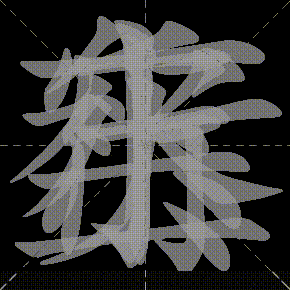
> 2
With each stroke entered on a Wubi* keyboard, the number of matches reduces significantly. It’s like entering more and more precise google search terms.
I entered the next stroke, 乛, a hook. The display slowed a bit, barely noticeable as the search space narrowed to hundred results and became a measure less frenetic. Cues offered by my interface indicate the most likely matches. I’d recruited one of the early search algorithm wizards from Alphabet (Google) to streamline the character search. Latency was not acceptable when you’re writing. Latency was hardly even a thing these days.
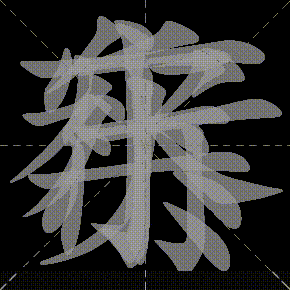
> 2-5
Character look-up is simply a matter of cross reference from a code to a certain position in a table. Character search is something else where a full database is traversed, narrowed by a descriptive set of terms, in this case stroke and order.
I entered the third, a left-falling stroke (丿) and my grid display slowed considerably, cycling between three likely and seven less likely matches. It’s not like at this point I really had to absolutely identify each of the matches I was seeing, rather I knew in my brain, I could see in my mind’s eye, what I was looking for. The whole process was quick, direct. It felt like the future.
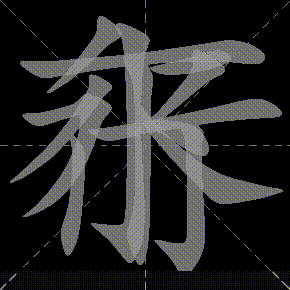
> 2-5-3
“For us, of course, things can change so abruptly, so violently, so profoundly, that futures like our grandparents’ have insufficient ‘now’ to stand on. We have no future’s because our present is too volatile.”
I clicked my display again, entering one final stroke, right-falling (丶).
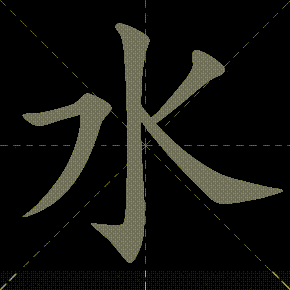
> 2-5-3-4
My display came to a definitive halt on one matching character waiting to be accepted. I tapped, selected, and pressed “send.” The Telegram left my immediate concern arriving on the opposite side of Earth, where the character landed on someone’s device, was correlated to its Unicode position, drawn in a simplified Chinese font, displayed, read, understood, and furtively distributed. Then something happened.
